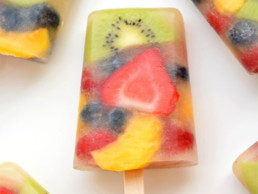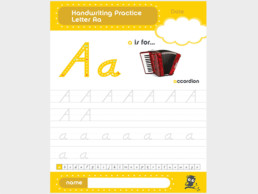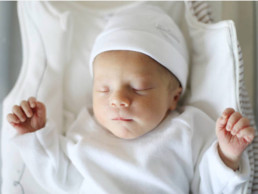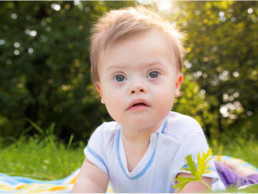How to Make Fresh Fruit Popsicles
This is a fun, easy and surprisingly very educational activity that you can do at home with your little chefs! It is so easy in fact, that they will barely need your help. We do it at our CEFA Early Learning schools for our little chefs program, and I can’t decide if they like making it or eating it more. All you need is fruit, water and a popsicle mold.
The best part is that this is also a great activity to teach your child how to eat healthy.
Best Ages for This Activity
6 months to five years
How to Make It
Ingredients (for two portions)
- Popsicle molds (alternatively, use small cups that you can freeze and popsicle sticks)
- 2 lemons (to make homemade lemonade)
- 3 drops of Stevia (you can add a few more drops to your liking). I chose Stevia because it is a natural sweetener which I consider better than sugar, but you can use white sugar if you prefer
- 3 cups water
- ½ cup blueberries
- 6 strawberries
- 1 kiwi
- 1 peach
- 1 banana
You Will Also Need
- A butter knife or plastic knife for your child to safely cut the fruit
- A lemon juicer sturdy enough for your child to use. If you don’t have one, squeeze the lemon with your hands. If you make a lot of lemonade or freshly squeezed orange juice (an essential ingredient for mimosas), you might want to invest in every child’s dream (and my personal favorite) – a citrus press.
Let’s Get Started!
- Invite your child to make homemade popsicles
- Wash the fruit together (I always mean for your child to do most of it, so they get as many learning opportunities out of one activity as possible).
- Cut the fruit (bananas, strawberries, kiwis) into slices, and then again onto smaller pieces if it is a large fruit like a peach. You can use whatever fruits you and your child like, and even try different fruit mixes each time you make them. What is important here is that your child cut the fruit into slices. It is a valuable learning experience (it is part of the life skills taught by the Montessori program, as well as the CEFA Early Learning schools program), and also a perfect way to practice fine motor skills. Even a six-month-old can cut a banana. You can help with the harder or more difficult fruit (like the peach) if your child is very young.
- Place the fruit, one by one, in the popsicle molds (for example, your child can figure out how to divide the slices of strawberry equally amongst six popsicle molds, learning essential math concepts, then doing the same with the rest of the fruit). If your child has a difficult time dividing the fruit into six piles that look to be about the same quantity, try one to one correspondence instead (“one blueberry in this mold, one blueberry in this mold, one blueberry in this mold”, etc.) and start over when you have filled all six molds, with another blueberry in each (‘one more blueberry in this mold”, etc.) and then again until you run out of blueberries, then do the same with the rest of the fruit. These seem simple concepts to an adult, but for your child you are providing an opportunity to develop a very strong mathematical foundation that they will need before moving on to more complex math equations (adding, multiplying, matching, sorting, and more). Take your time with this step, knowing that your child is learning more than how to make fruit popsicles.
- Once all the fruit is in the popsicle molds, make the lemonade:
- Squeeze the juice of 2 lemons onto 1½ cups of water, add in a few drops of Stevia to your liking to sweeten it, taste it and add more lemon or more water according to yours and your child’s preferences.
- Your child can pour the lemonade into the popsicle molds filled with fruit, leaving a little space for the water to expand as it freezes (your child can leave “one finger” of space – their finger not yours). You don’t have to use lemonade, you can use diluted apple juice, freshly squeezed orange juice, or even stevia-sweetened water.
- Your child can then carefully place the lids of the popsicle molds on each mold (you can hold the mold while they do it), and take the molds to the freezer, being careful to ensure that the molds are straight and do not spill. Again, these are important skills for your child to learn, so be patient while they figure it out. You can help by making a little space on a freezer shelf ahead of time.
- Now comes the hardest part: waiting until the popsicles are ready. They will take about 6 hours. You can help your child set a timer, which will again work on the mathematical concepts of time measurement.
- The last thing to do is clean up, which your child should absolutely be involved in. Teach them what goes in the compost bin, what goes in the garbage, how to wipe the table, how to wash the remaining dishes or place them in the dishwasher so they get properly washed. Again, all important life skills. The best part is that while you clean up together, you can keep an eye on the timer and see how much time elapses. This is fascinating for children!
- Once they are ready, your child can proudly serve the popsicles they made to the whole family! What a wonderful way to contribute.
Learning Opportunities
I love helping children learn to cook because it is a great life skill and an incredible way to contribute, to give of yourself to others, to do something for someone other than yourself, which children both love doing and need to do. Children will learn S.T.E.M. while measuring, dividing, learning to cut into equal slices, etc. This recipe also has a great amount of fine motor skills, a precursor to writing. Following directions also teaches the reading and S.T.E.M..
Doing this activity together also is a great opportunity for you and your child to connect. You can share life stories, ask them about them, their plans, and get closer. You can ask, for example:
- Who are you preparing popsicles for?
- How many popsicles will we need then?
- What is your favorite fruit? What is theirs?
- What other fruit combinations do you want to try next time?
- What other juice would you like to try next time instead of lemonade?
- What should we do with the fruit that doesn’t fit in the popsicle molds?
- Do you remember a time when we had popsicles as a family? What did you like about it? (you can also share your favorite popsicle family time from when you were a child)
- Who else likes popsicles? (grandma? Uncle? Friends from school?)
Distributing the popsicles equally amongst all family members is also 1 to 1 correspondence – a math concept. It also works on the math concepts of estimating quantities, measuring, division, and many others.
Cutting the fruit, taking the molds to the freezer, cleaning the workspace and the dishes are essential life skills. Learning to compost and recycle what is left teaches your child to care for the environment and contribute. Cooking is also an important life skill and sharing what they cooked with the rest of the family teaches your child the habit of contribution and thinking of others.
Extended Learning Opportunities
- Dramatic Arts: set up an ice cream truck, store or stand (you can make it out of cardboard if you wish, and paint it with your child) to “sell” the popsicles.
CEFA tip: Remember to let your child do as much of the process as they are capable of.
Books Your Child Might Like
Toys Your Child Might Like
Alphabet Writing Practice Sheets – A to Z Musical Instruments
These worksheets are used at our CEFA Early Learning schools for our 4 year old children (Junior Kindergarten Three), and presented only after our students have had practice with lowercase letters.
If your child is heading to kindergarten and you would like to try these at home, make sure you follow the directions indicated on the large letters (green means start, red means stop, and the arrows will point you in the right direction.
We teach this to our students one child at a time, as the teacher needs to observe to make sure the child is following the right directions (otherwise they are learning it and practicing it wrong, which will impact their writing skills in the future). Make sure you do the same so your child can learn to write the right way (no pun intended!).
You can download the practice sheets here.
Best Ages for This Activity
Four to five
How to Make It
Ingredients
- Paper
- A printer
Let’s Get Started!
- Print the worksheets
- Invite your child to practice writing
- Give them a fine felt marker if they are beginners, because a pencil is harder for them
- Only do a maximum of one worksheet a day
- If your child wants to keep working, invite them to draw the instruments corresponding to each letter instead. Drawing is excellent to prepare your child to write.
Learning Opportunities
This activity will give your child literacy skills: they will learn writing
skills as they trace the letters and reading skills as they identify the letter and the sound it makes, as well as try to read the name of the instrument, with your help.
Since the worksheets are all about musical instruments, your child will also learn about music.
Extended Learning Opportunities
- Talk about the instruments and what they sound like.
- Find a video of someone playing each one of those instruments (youtube is your friend here) so your child can hear what it sounds like
- Visit a music store to see some of these instruments firsthand
- Find out which letters are in your child’s name
- See which letters are in your name, in their siblings’ names, etc.
- Help your child write their name at the bottom of the practice sheet
Toys I Recommend for 2 Year Olds
By age two, your child’s muscles have developed and they can not only walk but also run, climb, throw and kick! They are fiercely protective of their independence and want to do everything they can on their own. Your two year old is also able to scribble, paint, stack a few blocks and is interested in many more things! They are still developing very quickly, which means that now more than ever, they need your patience and understanding.
Here are some toys I would recommend for that age:
| Learning | Ages | |
| Writing
Fine motor skills S.T.E.M. |
2-4 | |
| Writing
Fine motor skills |
2-4 | |
| S.T.E.M.
Dramatic play Social and emotional development Fine motor skills |
2-5+ | |
| Art
Fine motor skills Writing Creative play |
2-5
|
|
| S.T.E.M.
Creative play Reasoning Fine motor skills Engineering Dramatic play |
2-5 | |
| S.T.E.M.
Creative play Reasoning Fine motor skills engineering |
2½-5 | |
| Fine motor skills
Hand-eye coordination Reasoning S.T.E.M. |
2-4 | |
| Literacy
Fine motor skills Hand-eye coordination Reasoning S.T.E.M. |
2-4 | |
| Literacy
Fine motor skills Hand-eye coordination Reasoning |
2-5 | |
| Literacy
Fine motor skills Hand-eye coordination Reasoning Dramatic play |
2-3 | |
| Writing
S.T.E.M. Reasoning Fine motor skills |
2-3
|
|
| Social and emotional development
S.T.E.M. Literacy
|
2-5+ | |
| Writing
Reading Reasoning Fine motor skills |
2-4
|
|
| Literacy
Fine motor skills |
2-5 | |
| S.T.E.M.
Reasoning Fine motor skills |
2-3
|
|
| Reasoning
Natural science Contribution |
2-5+ | |
| S.T.E.M.
Fine motor skills |
2-5 | |
| S.T.E.M.
Fine motor skills Reasoning Reading
|
2-5 | |
| S.T.E.M.
Fine motor skills Reasoning Reading
|
2-5 | |
| S.T.E.M.
Fine motor skills |
2-3 | |
| S.T.E.M.
Fine motor skills |
2-3 | |
| Literacy
Fine motor skills |
2-5 | |
| Fine motor skills
Literacy Creative play Art
|
2-5+ | |
| Reasoning
Fine motor skills Literacy
|
2-4
|
|
| Writing
Reading Reasoning Fine motor skills
|
2-4 | |
| S.T.E.M.
Fine motor skills Reasoning |
2-5+
|
|
| S.T.E.M.
Reasoning Fine motor skills |
2-3 | |
| Reasoning
Fine motor skills S.T.E.M. |
2-4 | |
| Sensory play
Fine motor skills |
2-5+ | |
| Dramatic play | 2-5+
|
|
| S.T.E.M.
Creative play Fine motor skills Reasoning Dramatic play |
2-5
|
|
| S.T.E.M.
Creative play Fine motor skills Reasoning Dramatic play |
2-5+
|
|
| S.T.E.M.
Creative play Fine motor skills reasoning |
2-5 | |
| S.T.E.M.
Creative play Fine motor skills Reasoning Dramatic play |
2-5 | |
| S.T.E.M.
Creative play Fine motor skills Reasoning Dramatic play |
2-5
|
|
| S.T.E.M.
Creative play Fine motor skills Reasoning Dramatic play |
2-5
|
|
| S.T.E.M.
Fine motor skills literacy |
2-5
|
|
| S.T.E.M.
Fine motor skills literacy |
2-5
|
|
| Creative play
Dramatic play |
2-5+ | |
| Literacy
Fine motor skills Reasoning S.T.E.M. |
2-4 | |
| Literacy
Fine motor skills Reasoning S.T.E.M. |
2-5
|
|
| Gross motor skills
Physical education
|
2-5 | |
| Physical education
Coordination Gross motor skills
|
2-5+ |
Toys I have recommended in previous years that your child can still learn from:
| Learning | Ages | |
| Dramatic play
Reasoning Fine motor skills S.T.E.M. |
1-4 | |
| Dramatic play
Reasoning Fine motor skills S.T.E.M. |
1-3 | |
| S.T.E.M.
Fine motor skills reasoning |
1-5
|
|
| S.T.E.M.
Fine motor skills reasoning |
1-3 | |
| S.T.E.M.
Fine motor skills Reasoning reading |
1-2 | |
| S.T.E.M.
Fine motor skills Reasoning reading |
1-3 | |
| S.T.E.M.
Fine motor skills reasoning |
1-3
|
|
| Math
Fine motor skills Dramatic play |
1-5 | |
| Music
Reasoning |
0-4 | |
| Music
Fine motor skills Cause and effect |
0-5+ | |
| Music
Hand-eye coordination Fine motor skills |
0-4 | |
| Music
S.T.E.M. Literacy |
0-5 | |
| Music
S.T.E.M. |
0-5+
|
|
| Sensory learning
Empathy (as they get older) Dramatic play (as they get older) |
||
| Fine motor skills (writing)
S.T.E.M.
|
0-5
|
|
| Fine motor skills
Gross motor development Cause and effect Math |
0-3 | |
| Sensory Learning
S.T.E.M. Motor development |
0-3 | |
| Sensory Learning
S.T.E.M. Motor skills |
0-3 | |
| S.T.E.M. | 0-5 | |
| S.T.E.M. | 0-5 | |
| Sensory Learning
S.T.E.M. Dramatic play (as they get older) |
||
| Sensory Learning
S.T.E.M. Fine motor skills |
||
| S.T.E.M.
Fine motor skills |
0-5 | |
| Gross motor skills
Social + emotional development Object permanence Physical education
|
0-5 | |
| Gross motor development
Physical education |
0 (9mo)-3 | |
| Gross motor skills
Physical education |
1-4 | |
| Dramatic play
Writing Math
|
1-5+ | |
| S.T.E.M.
Fine motor skills Creative play |
1-5+
|
|
| Engineering
S.T.E.M. Fine motor skills Imaginative play |
1-5+
|
|
| Engineering
S.T.E.M. Fine motor skills Imaginative play |
1-3
|
|
| Engineering
S.T.E.M. Fine motor skills Imaginative play Literacy |
1-3
|
|
| Engineering
S.T.E.M. Fine motor skills Imaginative play |
1-3
|
|
| Art
Fine motor kills writing |
0
1 2
|
|
| S.T.E.M.
Reasoning Fine motor skills |
1-3
|
|
| Writing
S.T.E.M. Reasoning Fine motor skills Natural science |
1-2
|
|
| Dramatic play | 1-5
|
|
| S.T.E.M.
Fine motor skills Reasoning |
1-4 | |
| Dramatic play
Creative play Fine motor skills S.T.E.M. |
1-3 | |
| Dramatic play
Creative play S.T.E.M. |
1-5 | |
| Writing
S.T.E.M. Reasoning Fine motor skills Natural science |
1-3 | |
| Dramatic play
Vocabulary Literacy Creative play |
1-4
|
|
| Dramatic play
Social and emotional development Empathy |
1-5
|
|
| Hand-eye coordination
Fine motor skills S.T.E.M. |
1-3
|
|
| Dramatic play
Hand-eye coordination Fine motor skills Creative play |
1-2
|
|
| S.T.E.M.
Creative play |
1-5
|
|
| Music
Reading Fine motor skills |
1-5
|
|
| Music | 1-3 | |
| Music
Reading Math
|
1-5+ | |
| S.T.E.M.
Reasoning Fine motor skills |
1-3 | |
| S.T.E.M.
Fine motor skills |
1-3 | |
| Art
Fine motor skills Writing Imaginative play
|
1-5+ | |
| Fine motor skills
Writing Imaginative play
|
1-5+
|
|
| Dramatic play
Cause and effect Motor development |
1-3 | |
| Dramatic play
Reasoning Fine motor skills S.T.E.M. |
1-3 | |
| Reasoning
Fine motor skills S.T.E.M. |
1-3 |
Toys I Recommend for 1 Year Olds
By age one, children have learned so much already and are ready for toys that are a little more complex. This year, your baby will change from a baby to a toddler in every way: physically, emotionally and socially. They will gain new motor skills and begin to walk if they are not already walking. They will be much more independent and interact more with others as well. You will delight in discovering their personality, unique sense of humour and incredible curiosity!
Here are some toys I would recommend for this age:
| Learning | Ages | |
| Dramatic play
Writing Math |
1-5+ | |
| S.T.E.M.
Fine motor skills Reasoning |
1-3
|
|
| S.T.E.M.
Fine motor skills |
1-2
|
|
| S.T.E.M.
Fine motor skills Creative play |
1-5+
|
|
| Engineering
S.T.E.M. Fine motor skills Imaginative play |
1-5+ | |
| Engineering
S.T.E.M. Fine motor skills Imaginative play |
1-3 | |
| Engineering
S.T.E.M. Fine motor skills Imaginative play Literacy |
1-3 | |
| Engineering
S.T.E.M. Fine motor skills Imaginative play |
1-3 | |
| Art
Fine motor skills Writing |
0-2 | |
| Writing
S.T.E.M. Reasoning Fine motor skills Natural science |
1-2 | |
| Writing
S.T.E.M. Reasoning Fine motor skills Natural science |
1-2 | |
| Writing
S.T.E.M. Reasoning Fine motor skills Natural science |
1-3 | |
| Writing
S.T.E.M. Reasoning Fine motor skills |
1-2 | |
| Writing
Reading Reasoning Fine motor skills |
1-4 | |
| S.T.E.M.
Fine motor skills reasoning |
1-2 | |
| S.T.E.M.
Fine motor skills Reasoning |
1-5
|
|
| S.T.E.M.
Fine motor skills Reasoning |
1-3 | |
| S.T.E.M.
Fine motor skills Reasoning Reading |
1-2 | |
| S.T.E.M.
Fine motor skills Reasoning Reading |
1-3 | |
| S.T.E.M.
Fine motor skills reasoning |
1-3 | |
| S.T.E.M.
Fine motor skills Reasoning |
1-4 | |
| S.T.E.M.
Reasoning Fine motor skills |
1-2 | |
| S.T.E.M.
Reasoning Fine motor skills |
1-3 | |
| S.T.E.M.
Reasoning Fine motor skills |
1-3 | |
| S.T.E.M.
Reasoning Fine motor skills |
1-3 | |
| S.T.E.M.
Reasoning Fine motor skills |
1-3 | |
| S.T.E.M.
Fine motor skills |
1-3 | |
| Art
Fine motor skills Writing Imaginative play |
1-5+ | |
| Fine motor skills
Writing Imaginative play |
1-5+ | |
| Dramatic play
Cause and effect Motor development |
1-3 | |
| Dramatic play
Reasoning Fine motor skills S.T.E.M. |
1-3 | |
| Dramatic play
Reasoning Fine motor skills S.T.E.M. |
1-3 | |
| Dramatic play | 1-5 | |
| Dramatic play
Creative play Fine motor skills S.T.E.M. |
1-3 | |
| Dramatic play
Creative play S.T.E.M. |
1-5 | |
| Dramatic play
Vocabulary Literacy Creative play |
1-4
|
|
| Dramatic play
Social and emotional development Empathy |
1-5
|
|
| Hand-eye coordination
Fine motor skills S.T.E.M. |
1-3
|
|
| Dramatic play
Hand-eye coordination Fine motor skills Creative play |
1-2
|
|
| S.T.E.M.
Creative play |
1-5
|
|
| Sensory play
Fine motor skills |
1-5+
|
|
| Music
Reading Fine motor skills |
1-5
|
|
| Music | 1-3 | |
| Music
Reading Math |
1-5+ | |
| Gross motor skills
Physical education |
1-4 |
Toys I have recommended from the previous year that your child can still learn from:
| Learning | Ages | ||
| Sensory learning
Teething Motor skills |
0-2
|
||
| Teething
Sensory learning |
0-2
|
||
| Sensory learning
Empathy (as they get older) Dramatic play (as they get older) |
0-5
|
||
| Cause and effect
Reasoning Motor skill development |
0-1 | ||
| Cause and effect
Reasoning Motor skill development |
0-1 | ||
| Cause and effect
Music Reasoning Motor skill development |
0-3 | ||
| Cause and effect
Walking Motor skill development |
0-2 | ||
| S.T.E.M.
Fine motor skills |
0-2
|
||
| Music
Reasoning
|
0-4 | ||
| Music
Fine motor skills Cause and effect |
0-5+ | ||
| Music
Hand-eye coordination Fine motor skills |
0-4 | ||
| Music
S.T.E.M. Literacy |
0-5 | ||
| Music
S.T.E.M. |
0-5+ | ||
| S.T.E.M.
Music Hand-eye coordination Fine motor skills |
0-2 | ||
| Motor development
S.T.E.M.
|
0-1 | ||
| S.T.E.M.
Fine motor skills
|
0-1 | ||
| Fine motor skills (writing)
S.T.E.M.
|
0-5 | ||
| Motor development
S.T.E.M.
|
0-2 | ||
| Motor development
Cause and effect Math
|
0-1
|
||
| Fine motor skills
Gross motor development Cause and effect Math
|
0-3
|
||
| Sensory Learning
S.T.E.M. Motor development |
0-3
|
||
| Sensory Learning
S.T.E.M. Motor skills |
0-3
|
||
| Sensory learning
Serve and return Motor development |
0-3 | ||
| Sensory Learning
S.T.E.M. Motor skills |
0-3
|
||
| Sensory Learning
S.T.E.M. Motor skills |
0-1
|
||
| S.T.E.M. | 0-5 | ||
| S.T.E.M. | 0-5 | ||
| Sensory Learning
S.T.E.M. Dramatic play (as they get older) |
0-3
|
||
| Sensory Learning
S.T.E.M. Fine motor skills |
0-3 | ||
| S.T.E.M.
Fine motor skills |
0-5 | ||
| Sensory play
Literacy S.T.E.M. |
0-2 | ||
| Cause and effect
S.T.E.M. literacy |
0-2 | ||
| Writing
Fine motor skills S.T.E.M. Reasoning Sensory learning |
0-2 | ||
| Gross motor skills
Social + emotional development Object permanence Physical Education |
0-5 | ||
| Gross Motor Skills
Self-help skills |
0-4 | ||
| Gross Motor Development
Physical Education |
0-4 | ||
Toys I Recommend for Infants
Before they turn one, babies learn through their senses. They can make eye contact, smile, grasp objects and bring them to their mouth to learn even more about them. What they need most of all is adult interaction: talking, singing, reading to baby, holding them and caressing them, rocking them, are all essential. You can read more about how your baby learns in this article.
Newborns are learning so much already, getting to know those closest to them, and all the sounds, sights and smells around them. As they develop, choose simple toys that engage baby, that encourage sensory exploration, motor skills, and cause and effect.
Here are some ideas:
| Learning | Ages | |
| Sensory learning
Fine motor skills Cause and effect |
0-1
|
|
| Sensory learning
Fine motor skills |
0-1 | |
| Sensory learning
Fine motor skills |
0-1 | |
| Sensory learning
Fine motor skills |
0-1 | |
| Sensory learning
Fine motor skills |
0-1
|
|
| Sensory learning
Fine motor skills |
0-1 | |
| Sensory learning
Fine motor skills |
0-1
|
|
| Writing
Sensory Learning Fine motor S.T.E.M. Reasoning |
0-2
|
|
| Sensory learning
Fine motor skills |
0-1 | |
| Sensory learning
Teething Motor skills |
0-2
|
|
| Sensory learning
Teething |
0-2
|
|
| Sensory play
Fine Motor development |
0-1
|
|
| Sensory learning
Dramatic play Teething |
0-3 | |
| Sensory learning
S.T.E.M. Motor development |
0-1 | |
| Sensory Learning
S.T.E.M. Motor development |
0-3
|
|
| Sensory Learning
S.T.E.M. Motor skills |
0-3
|
|
| Sensory learning
Serve and return Motor development |
0-3 | |
| Sensory learning
S.T.E.M. Motor skills |
0-3
|
|
| Sensory Learning
S.T.E.M. Motor skills |
0-1
|
|
| Sensory Learning
S.T.E.M. Dramatic play (as they get older) |
0-3
|
|
| Sensory Learning
S.T.E.M. Fine motor skills |
0-3 | |
| Sensory learning
Empathy (as they get older) Dramatic play (as they get older) |
0-5
|
|
| Sensory learning
Music Cause and effect |
0
|
|
| Sensory learning
Cause and effect Gross motor development |
0
|
|
| Sensory learning
Music Cause and effect |
0
|
|
| Sensory learning
|
0-1
|
|
| Sensory play
Literacy S.T.E.M. |
0-2 | |
| Cause and effect
Motor skill development |
0-1 | |
| Cause and effect
Reasoning Motor skill development |
0-1 | |
| Cause and effect
Reasoning Motor skill development |
0-1 | |
| Cause and effect
Music Reasoning Motor skill development |
0-3 | |
| Cause and effect
Walking Reasoning Motor skill development |
0-2 | |
| Cause and effect
Walking Motor skill development |
0-2 | |
| Cause and effect
S.T.E.M. literacy |
0-2 | |
| Music
Reasoning |
0-4 | |
| Music
Fine motor skills Cause and effect |
0-5+ | |
| Music
Hand-eye coordination Fine motor skills |
0-2 | |
| Music
Hand-eye coordination Fine motor skills |
0-4 | |
| Music
S.T.E.M. Literacy |
0-5 | |
| Music
S.T.E.M. |
0-5+
|
|
| S.T.E.M.
Music Hand-eye coordination Fine motor skills |
0-2 | |
| S.T.E.M.
Fine motor skills |
0-2
|
|
| S.T.E.M.
Motor development |
0-1 | |
| S.T.E.M.
Fine motor skills |
0-5 | |
| S.T.E.M. | 0-5 | |
| S.T.E.M. | 0-5 | |
| S.T.E.M.
Fine motor skills |
0-1 | |
| S.T.E.M.
Fine motor skills (writing) |
0-5
|
|
| S.T.E.M.
Fine motor skills Sensory learning |
0-1 | |
| Motor development
S.T.E.M.
|
0-2 | |
| Motor development
Cause and effect Math |
0-1
|
|
| Fine motor skills
Gross motor development Cause and effect Math |
0-3
|
|
| Gross motor skills
Social + emotional development Object permanence Physical education |
0-5 | |
| Gross motor skills
Fine motor skills Sensory learning |
0-1 | |
| Gross motor skills
Self-help skills |
0-4 | |
| Gross motor development
Physical education |
0 (9mo)-3 | |
| Focus
Visual learning |
0-1 | |
| Social+emotional development
Motor development |
0 | |
| Social+emotional development | 0-3 |
Magic Milk Experiment
This incredibly simple science experiment will mesmerize your child! Using only dish soap, milk, food coloring and a q-tip, your child can learn about chemical reactions. They will set off an explosion of color that keeps changing in waves, right before their eyes. Our students at CEFA Early Learning schools love it!
I guarantee that your child (and you) will love this hands-on experience.
Best Ages for This Activity
One to five
How to Make It
Ingredients
- ¾ cups whole milk (it can work with 1% or 2% but it’s much better with whole milk)
- 3 drops (per colour) of liquid food colouring of various colors (you can try it with just one color, but I really encourage you to do it with at least 4 colours if not more!) any type of food coloring is fine J
- Liquid Dish soap of any kind
- 1 white dinner plate (or similar flat white container)
- 1 q-tip
Let’s Get Started!
- Invite your child to try a science experiment
- Pour the milk in the plate (make sure it completely covers the bottom of the plate) and let the milk settle
- Add a few drops of each color of your food coloring, making sure they don’t touch but put them close together. You can do just a few drops and put them in the centre of the plate, or you can try doing it like this example:

- Soak one end on your q-tip in dish soap

- Ask your child: “What do you think will happen if we dip this soapy q-tip in the milk?” and have your child make a prediction (a hypothesis).
- Invite your child to try it: touch the tip of the cotton swab to the centre of the milk and leave it for 10 to 15 seconds without stirring it. You will be amazed at the beautiful reaction of the colors in the milk! A picture does not do it justice, please try it.
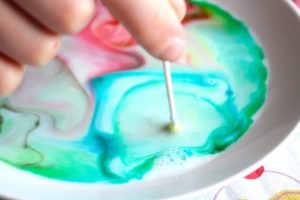
- Did your child predict what was going to happen? What did happen?
- You can try it as many times as you want, each time adding a drop of soap to the q-tip. You can also experiment putting the soapy q-tip in different places in the milk. Notice that the colors in the milk continue to move even when you remove the q-tip.
- Ask your child: “Why do you think the colors are moving? What is happening?”
The Science Behind This Experiment:
Milk is made up of mostly water but it also contains minerals, vitamins, proteins and fat. The fats and proteins react to the soap.
The molecules of fat bend, roll and twist in all directions as the soap molecules race around to join up with the fat molecules. You wouldn’t see this chemical reaction without the food coloring! During all of this fat and soap molecules movement, the food coloring is getting bumped and pushed around, providing an easy way to observe all the invisible activity.
The soap molecules are trying to catch all the fat molecules. When there is no more movement, all the fat molecules have been found. Are there any more hiding? Try another cotton swab dipped in soap and see what you can find!
Learning Opportunities
This is a thrilling S.T.E.M. activity where your child can see a chemical reaction as it happens. For better science learning, follow the steps of your scientific method with your child. Make sure you use as much math vocabulary as you can (for example, name the colors; observe if the movements are fast or slow, or slowing down; see the difference when you add soap near a big drop of food coloring versus a small drop; see if the color touches the edge of the plate or if it stays I the centre; see if it goes to the left or to the right; etc.)
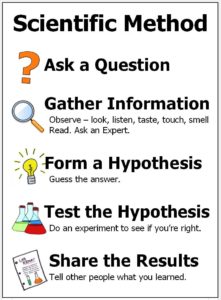
Extended Learning Opportunities
- Try the experiment again, but this time have three plates: one with whole milk, one with 1% milk and one with water. Does the same reaction happen in all three plates? Why?
- Tip: the more fat, the more fat molecules there are to join with the soap molecules, and therefore the bigger the reaction.
- Invite your child to draw their observations.
CEFA tip: Remember to let your child do as much of the process as they are capable of.
Books Your Child Might Like
Toys Your Child Might Like
For 3 year olds and older:
For 5 year olds and older:
How to Help Your Infant Learn
With a newborn in your arms, there are already so many things you are thinking about: making sure your baby is fed, kept warm enough, getting enough rest, changed and clean. The last thing on your mind at this stage is probably education. Can your baby really learn this early? And if so, how do you “teach” your baby at this age?
The answer is that your baby is learning, and at an incredibly rapid pace. Your baby is constantly learning from the moment they are born. The good news is that there is probably very little you need to do, aside from what you are already doing to facilitate your baby’s brain development in the first few months.
It is important to understand the developmental changes that are taking place and know that you play a fundamental role in your baby’s development, beyond physical care.
Developmental milestones most often discussed with your physician are physical milestones, not cognitive ones. However, there are particularly important developments, especially regarding language, taking place in your child’s brain. Your new baby is learning to communicate and to understand their environment. For this to happen, your baby needs to bond with you emotionally at a very deep level.
Your interaction with your baby, both physical and verbal, your prompt response to their needs, and the environment around your baby will deeply affect your baby’s bond with you and their trust in you. This in turn will affect their relationships with the rest of the family and the outside world, now and for years to come.
During the First Month
During this time, your baby needs to know that you will respond to their needs. Feed them when they are hungry (rather than on a strict schedule), soothe them when they are tired, change them when they are soiled, and most importantly, hold them. Hold your baby often and as close to your body as possible – skin to skin whenever you get the chance. This alone will take care of forming vital connections in your baby’s brain, and also help your baby grow physically. Do not be afraid of “spoiling” your baby because your baby needs you to hold them. This is when the learning happens during the first month. When you are feeding your baby, talk to them, look at them, gently sing to them and focus on them until they are asleep. Leave the TV or cell phone for when you are not with them. Your baby is bonding with you, and learning to recognize your voice, your facial features and your smell. Don’t try to be ultra-productive and reply to your e-mails while baby is busy feeding - baby needs that interaction, and it also fills you with endorphins, and gives you the strength you need during all the sleepless nights.
During the Second and Third Months
By the end of the first month, babies already begin to act less out of reflex and more out of slight expectations they have learned. They expect the same people to hold them, they expect to be picked up when they cry, and they anticipate being fed when they hear the voice of their mother nearby. They also expect being sung to, rocked, or to receive pats on their back after feeding. They are getting used to all the routines you have established, and the little things you have been doing with them – they learned them. All these familiar habits teach your baby to trust you as the person who cares for them.
Learning Through Habits or Routines
During this time, it is recommended that you keep these routines consistent to help your baby learn. For example, if you generally sing to your baby while you rock them, always do it so your baby learns to expect it. This is when your baby is learning to “connect the dots” and begin making sense of their world. It is also what will teach your baby that the world is a place they can trust, which is essential for their emotional development.
To help your baby make sense of the world, here are some routines you can establish:
- Help your baby predict what comes next by gently guiding their schedule to adjust to an established one. For example, rather than going to bed whenever you feel tired each night, or getting up when you wake up, regardless of what time that is, try slowly making the environment more quiet and darker at the same time each night, and you will see that in a few weeks, both your baby and you will come to adjust to that time as your bed time.
- Wake up at the same time each morning. This will be good for your hormonal balance. When you are up, hold your baby even if they are still sleeping and try to feed them. Getting used to this morning feed will gradually establish the habit of waking up at the same time, which in turn will adjust your baby’s feeding times to a more predictable pattern. Please know that I am not suggesting you not feed your baby outside of their strict feeding times. Babies should be fed when they ask to be fed.
This will take anywhere from a few days to a few weeks, but it works. The trick is to choose the start time (early in the morning) even if your baby is not asking to feed and keeping bedtime consistent. Your baby will still feed throughout the night, because they are growing and need to feed constantly. Babies are not biologically equipped to sleep through the night without being fed, and I strongly advise against letting your baby cry, unattended. Your baby needs to eat, and if you ignore their cries, you are breaking the patterns of predictability for your baby. That, according to research, can affect them emotionally, for life. - Other routines include giving your baby a bath at the same time each day or going for a walk outdoors at the same time, or anything you do on a daily basis. These routines will help your child’s brain development, social development, and emotional development.
Learning Through Hearing
From the time your baby was in the womb, they learned to recognize the voice of their mother, and the voices of those they heard frequently. Listening to every sound around them plays a huge part in your child’s brain development. Your baby’s brain is busy listening, recognizing and classifying every noise and soon enough, every phonetic sound around them. This is how your baby learns to speak. How much you speak to your baby, as well as how you do it, will make a big difference.
The environment will also influence that learning. Observe your baby to see what they are most comfortable with. Do they like an environment with music and busy sounds of pets, children, and plenty of conversation? Or do they like a more relaxing and quiet environment, where the only voices are of those closest to them. Every baby is different, but chances are your child will fall somewhere in between these two extremes most of the time. Even babies who love a more lively environment need some quiet times throughout the day, and vice versa. Learning to understand what your baby needs and when is a large part of your role as a parent. All you need to do is observe. But know this; a baby raised in complete silence and never spoken to will never learn to speak, and a baby who is constantly subjected to constant noise will develop anxiety and stress. Aim for a soothing environment in the first few days, and very gradually introduce your baby to new sounds, as the weeks go by. Remember that every sound is a new experience for your child. The first time they hear a bird chirp, or a dog bark, or a certain kind of music, or a loud laugh – every one of those new sounds is contributing to your child’s development, as long as the level of stimulation is just right.
Learning Through Language
Although language could fall under hearing, it does deserve its own category because this is where a parent can make a big difference. Research shows that how you speak to your baby, as well as how frequently you speak to them, has a great impact on your baby’s development. According to research, babies prefer hearing “motherese”, which is how most adults speak to a baby. It is almost a sing-song, and the vowels are elongated: “hellooooooo! How is baaaabyyyyy todaaaaay”? with a higher pitch.
Speaking to your child like this helps your child maintain their attention on you, recognize the phonetic sounds of the language (or languages) they are hearing, and learning to recognize words. Research shows that by six months of age, babies already begin losing the ability to “hear” certain phonetic sounds that are not used in their own language, which will help them learn to decipher words much faster. Speaking to your baby often (for example, during feeding, or when you go for a walk) and having a conversation – meaning, asking questions, sharing anecdotes, making comments in passing, just as you would with a friend - will affect a child’s IQ and vocabulary for life. This, in turn, affects your child’s success at school and in life.
Many parents, however, try to stick to simple vocabulary, and do not ask their babies questions (they think there’s no point since babies don’t answer), they do not converse. Instead, they tend to give their babies and toddlers simple “orders”, or direction; “pick up please!”, or “dirty”, or “no”.
It is strongly recommended that you speak to your baby from the very first day, just like you would speak to a friend or to your spouse (except for the higher pitch motherese, which I am sure your spouse wouldn’t like). “Good morning to you! How are you today? Did you sleep well? You woke up a few times last night, you must have been very hungry! Are you hungry now? Why don’t we sit outside to feed you, then we can hear the birds sing, and feel warmth of the sun on our skin…”
You can read stories to baby, or comment on a book you are reading yourself, even if your baby has their eyes closed. This will make a tremendous difference in your child’s development. When you talk to your baby, try to have no other distractions around, look at your baby by holding them in front of you and to wait for your baby to respond to what you say. You will see that even in the first month, your child will begin blinking, making facial expressions, making sounds or cooing, listening attentively, or moving in response to your dialogue. By the second month, they will even imitate some of your facial expressions, like blinking, opening your mouth, and sticking your tongue out. Make sure you give your child enough time to respond to you when you talk – it can take a minute or two. This kind of interaction is incredibly stimulating for your child, and an important aspect of their social development.
Learning Through Touch
Research shows that brain development is greatly influenced by the amount of physical touch a baby receives, from holding your baby, to rubbing your baby’s back, caresses and infant massages. Studies have shown that babies born prematurely had an 80% survival rate if they received kangaroo care (meaning their bodies were in constant contact, skin to skin, to that of the mother or even of another person), versus less than 20% if they were cared for in an incubator, and only held during feedings. The same goes for your baby at home; don’t be afraid of holding your baby too much! The closer you are to your baby, and the more physical touch your baby receives, the greater their emotional development and brain development. If you are going for a walk, why not choose a baby carrier instead of a stroller? You can stay close, your bodies together, and burn a few extra calories in the process!
Learning Through Sight
I once saw a movie where a man in his thirties recovered his sight for the first time in his life. Of course, the man was excited about the possibility of finally seeing the world around him, but those first few days where everything was so bright and had so many different shapes and colours were so overwhelming for him that they almost seemed unbearable. That was the first time I could truly understand how much visual stimulus a newborn is subjected to on a daily basis. Not to mention the fact that everything else is new too! Sounds, smells, being held, carried, rocked, everything! Although sight is a beautiful thing, be aware of how much your baby is exposed to at one time. Thankfully, their field of vision is much narrower at birth, and they can only focus on things that are close, but gradually, babies begin to see as well as we can. Although this naturally shields babies from excessive visual stimulus, you still want to be aware of when it gets to be too much. Bright noisy toys with lights should be kept far, far away for now. Remember also that an infant cannot turn their head, and therefore cannot look the other way when the stimulus becomes too intense. Pay particular attention to how intense the stimulus is around your baby’s crib, at least until your baby can turn their head.
Your baby is fascinated by facial features. This is another reason to look at your baby when they are feeding – they are learning from merely observing your face. As your baby gets older, begin associating what they see with what they hear, smell and feel. This will help them make even more connections in their brain!
Again, take your cues from your baby. When they are alert and looking around, talk to them and show them different objects. See if they can track a brightly coloured object held at about 15 cm, from side to side with their eyes while you move it. This is a wonderful learning exercise, and will also help them develop attention skills, which furthers their learning experiences. When your baby loses interest, the lesson is over.
As the parent of your newborn, you have a critical role to play in your baby’s early brain development. You have the responsibility of being responsive to your baby, interacting with them, providing an environment that is at times soothing and at times stimulating, and learning to understand the difference between the two. No two babies are the same, even when they are from the same family. What is stimulating for one child can be irritating for another. By observing and interacting with your baby in the ways described above, you will know exactly what your child prefers. However, one thing remains true; all children need a deep connection with their caregiver from the moment they are born. The more you are distracted, trying to fit everything into one day, the less your child has your attention, and the more you are negatively affecting their development, on a cognitive, social, emotional and physical level.
Great Outdoor Activities for the Body and the Brain
With the warm weather finally upon us, there are plenty of fun outdoor activities for our little ones to enjoy! Here are a few ideas that will benefit your child’s physical development, as well as their intellect and their imagination.
Smart Outdoor Activities for Babies
- Playing with sand: Sand play provides your baby with a great sensory experience, which sets the path for learning to write, among other important benefits. If you add toys to scoop and pour (any container from your kitchen will do) it also teaches them S.T.E.M. with mathematical concepts such as measurement, weight, and even addition and subtraction. Sand play also encourages scientific thinking in your baby and is the perfect environment for socializing (once we are finally able to) and imaginative play.
- Playing with water: Similarly to sand play, water provides great stimulation for the senses (they can feel the water with their bodies, if it is cold or warm, or if it changes temperature depending on its depth; they can also hear the noise it makes as it splashes and moves and literally stimulates all of your baby’s senses). Water play offers a number of opportunities for your child to learn S.T.E.M. (science, technology, engineering and math), to reason, to try building dams, or otherwise stopping the flow of the water, to measure, to compare its temperature, to try mixing sand or dirt into the water, to see if objects float or sink, or just to simply manipulate its course with their body. Water is the perfect learning experience for S.T.E.M. Even a small puddle of water provides endless learning opportunities and hours of fun. Always supervise and stay very close to your child while playing with water.
- Exploring the grass with their bodies: Babies love to feel and explore with their entire body. Help your baby walk on the grass with their bare feet, or crawl on it. Invite them to feel the grass and the Earth with their hands and talk to them about what they are feeling. To add more sensory stimulation, go from a soft blanket, to cool grass, or from dirt to mud, and walk over different textures, always commenting on how it feels to the touch. Smell the earth and the grass, the flowers, and all of nature around you. Count the flowers, notice their colours, find the insect and worms on the ground, name them, ask questions, even if your baby can’t talk yet, have a conversation with them. If you look closely, you will know exactly what your child is wondering, and put it into words for them. This is still great for their language and science development.
Smart Outdoor Activities for Toddlers
- Building with mud or sand: Take sand play a step further by introducing your child to tools they can use to build with. Appropriate tools include spoons, pails, shovels, and containers of different shapes and sizes. Your child will learn early mathematical concepts by working with various shapes and weights. They will also learn science, and creative thinking while comparing results and techniques as they discover the best way to build their structures. Building is engineering at its best and using tools in the early years is considered learning technology. You have a complete S.T.E.M. activity just by inviting your child to build a sandcastle, or a fort. As a parent you can enhance their learning by talking about their observations whilst they are playing. Bring a friend (or make a friend) for your child for added social skills.
- Observing insects: For a mere two dollars, you can buy plastic aquariums with perforated lids at a dollar store. One of those will last you until your child is ready to leave for college – they are a really great investment and provide the perfect little house for insects for a few days so your child can learn about them. If you can’t find one at the dollar store, here is one you can buy, or you can make your own. Bring it along with you and help your child carefully and gently collect bugs to observe for the day. Discover with your child what the insects need in their habitat and what they need to eat and drink. Encourage them to take photos and to draw their observations, either outside or later when they get home. This teaches your toddler about nature, and about science. It also teaches them empathy as they are learning to care for a living thing, and they also learn to return it to its natural habitat. It prepares your child for writing when you encourage them to draw their observations, and also when you help them write down what they observed (they can dictate to you). You can further enhance their learning by reading about insects, either outside, where they can see them, or later when you get home. This exercise is twice as much fun when you find tadpoles instead of ants!
- Collecting shells: If you are able to go to the beach this summer, this is a great chance to explore the ocean with your child. From dipping your feet in the water to looking for crabs and for shells. When I was 15, I used to take my little sister (who was 4 at the time) to the beach and look for small crabs hidden in the rocks. We would spend hours doing that, almost every weekend. You can look closely at sand with a magnifying glass (have you ever tried? It is fascinating!), you can collect water from the ocean in a jar to look at it later under the light, or with a flashlight. You can look at the plants that grow in the water and group your treasures by types (this teaches your child mathematics). For added adventure and learning, make a treasure map and follow the clues with your child until you find it together (you would have to bury the treasure when your child is not looking of course). Nothing is more delightful than digging out a buried treasure chest (these can also be purchased at the dollar store and filled with anything you like), and the treasure hunt itself provide added reading, writing and math skills. Bonus!
Smart Outdoor Activities for Young Children
- Building a fort: Use rocks, branches, and other natural elements around you to build a fort together. Here is an activity I created that shows you the learning benefits of building a fort. Figuring out how to build enhances your child’s reasoning, engineering and mathematical skills. Weaving and tying string, leaves and other elements together are wonderful for fine motor skills, which are precursors for writing. Explaining the process out loud adds vocabulary skills and doing it with a friend or a sibling adds another level of complexity and social skills.
- Make a mini habitat for your favourite toys: For example, one day at the age of four, my son spent over six hours outside playing with his dinosaurs. We found a garden of tall grasses and leaves, which was the perfect habitat for twenty of his dinosaurs. He made them a lake, a volcano, a hiding place and even a place to sleep. If your child is not into dinosaurs, try a fairy world, or try making a home for any of your child’s favourite toys – from trains to critters –Days like this are wonderful opportunities for dramatic and imaginative play, which is crucial in any discipline.
- Plant a garden: Gardening teaches your child about science and about life and nature. It teaches your child responsibility by having to tend to their garden daily and it teaches them about food and where it comes from (if you plant vegetables, for instance), this can also lead to good nutritional habits. Start from the very beginning by growing roots on an avocado, a potato or an onion, and plant them in glass jars to allow for better observation of the roots as they grow. Here is how to do it.
There are endless activities that your child can both enjoy and learn from; these are just a few examples. Spending time outside, rain or shine, and discovering the world around you from your child’s perspective is like seeing it again for the first time.
No matter what activity you choose, engage your child in conversation, regardless of their age. This will teach your child essential vocabulary, as well as help them understand how to put their feelings, and all their new discoveries, into words. You and your child can talk about it again once you are inside, and they can even draw their experiences, or journal about them. You can even scan and print those drawings (let’s say, they draw an ant, a ladybug, a worm and a caterpillar) for them to play with later and create stories with them. This is a great extension of their learning and teaches them creativity and imaginative play (dramatic play).
You can talk with your child about their drawings, and about their observations. You can look at the photos they took together, and exchange thoughts and questions, which will expand your child’s learning even further. If your child is interested, start a nature journal where every day, you can either draw or write about your outdoor experiences. This will be something that will not only extend their learning greatly, but also become a treasured keepsake throughout the years.
Have a wonderful time outside!
The Importance of Science In the Early Years
Children are natural born scientists. To nurture this type of learning in children, allow them to explore their environment safely and freely and with plenty of time.
Children have this fascinating sense of wonder and curiosity about the world. They build theories, test them, evaluate what worked and what didn’t, then figure out why.
They try to figure out why water and dirt combine to make mud, why some things float in the tub while others sink to the bottom. They try to understand how shadows work, or why caterpillars make cocoons.
Encouraging children to explore their natural curiosity is one of the best ways for them to learn science. It helps them think in an increasingly complex way. Science also allows children to see themselves as contributing individuals, as they are trusted to solve problems. The many benefits of exposing your child to science include:
- Advancement of critical and creative thinking as well as problem-solving
- Increased vocabulary, math and physics skills
- Perseverance and an understanding that failure helps them learn
- Patience as they observe nature around them, and discover some changes take time
- Worldliness as they take an interest in the world around them to discover how things work
- Critical thinking and the ability to form their own opinions and draw conclusions from observations
Are Children Ready to Learn Science?
Almost all young children are already learning science naturally, without any prompting. Most of the time they actively search for new knowledge and experiences in the world around them. They develop theories about what they see and how it works.
As many parents of young children will attest, their child’s favourite question for years is “Why?”. Their favourite activity is taking things apart, and they can spend hours in the park or garden, just observing how the ants transport the crumbs of their muffin into a tiny hole in the ground.
Children are eager to figure out why turning the light on makes everything so bright, or what happens if they plug something into the electrical socket. In an effort to keep them safe (and to keep the house a little cleaner), we as parents often stop them from discovering the world around them. Slowly, over the years, many children sadly lose that inquisitive spark they were born with. As a result, creative thinking is compromised. However, it is those same creative thinking skills that will help them succeed in the future by contributing new ideas or challenging the status quo.
Here’s How it Works
From the time they are born, children form concepts about what they see. As they grow, these concepts evolve and become more complex, as does their ability to make deductions and to problem-solve. As they do that, their knowledge expands, and they become more adept at observing. Children formulate their own hypotheses, and test those in an increasingly complex way. They then organize and classify the newly acquired knowledge, generalize across disciplines, relate it to their own life experiences, compare it to their previous ideas and the ideas of others. The more opportunities they have to do this, the better. They become good at reasoning, problem-solving and thinking. As they discover new ideas, their vocabulary also increases to allow them to describe what they are experiencing. The higher the vocabulary, the higher the IQ, and the better they do at school.
Children are geared to think just like scientists: they observe, predict, hypothesize, experiment, reflect on and communicate their findings.
How Can I Teach Science at Home?
Contrary to what many parents and teachers may think, science in the early years is not a complicated process. For children, science just happens. What you have to ensure as a parent is that your child’s questions are valued and appreciated. Take the time to listen and don’t be too quick to give the answer away. Instead, ask questions like “I wonder how we could find out the answer to your question?”. By doing this, you are modeling for your child how to learn, and where to look for knowledge. Some days you will search in a book, other times you will search on the computer, ask a friend, visit a museum, a science center, or a library. It all depends on the question. Doing this with your child will teach them that there are many ways to find the answer to a question. You can also encourage them to test their own ideas, their hypotheses.
Working together with your child to discover the answer will get them excited about the process. As your child gets in the habit of looking for answers with you, they will eventually do it on their own. Once that is established, they will be a lifelong learner. To get started, here are a few activities you could try:
Cooking
Cooking is a live science experiment in action. Involve your child in the kitchen when you prepare meals. It may take you a little longer, but you are providing the ideal science lab, teaching your child about food and nutrition, helping them feel needed and appreciated at home and equipping them with an excellent skill. Soon, your child will be cooking meals without help, and you will be glad you invested the time in teaching them. Blenders are great if you supervise, as are mixers and plastic knives for little ones. Try to teach them a few simple recipes they can do by themselves, like smoothies (with yogurt and fruit), or salad. Freeze yogurt for healthy ice creams, melt chocolate to re-shape it, mix flavours and colours, and have some fun in the kitchen. Increase the complexity as they grow. Teach them to follow a recipe (measure, mix, etc.) and also let them experiment with different ingredients, without the guidance of a recipe. In the kitchen, your child will learn S.T.E.M. principles like mixing, measuring, and changing matter when you combine ingredients.
Pets
Children love to observe animals to see the differences in how they communicate and behave. If you’re not ready for a pet, consider an aquarium, and if that is too much of a commitment, visit your garden or a pet store. Snails, butterflies, grasshoppers, worms, stick bugs, crickets, or any kind of insect make for great temporary pets, provided you supply leaves sprayed with a little water, dirt, sand, or pebbles. Figuring out what these insects need to eat and how they live is a discovery in itself. If the thought of a critter in your home is enough to give you nightmares, invite your child to observe outside, in the park or in your backyard. At home, you can show your child how to take care of plants instead, and what they need in order to thrive.
Water
If you have the courage, I strongly encourage you to explore water with your child. Remember that you must supervise water play at all times. Provide buckets, spoons and other digging utensils so they can mix in sand and dirt, and don’t forget pouring utensils. No need to buy anything fancy. You will find everything you need in your kitchen cupboards. The bathtub is also a great place to explore the properties of water. There you can explore with empty bottles they can fill and empty, add bubbles, add gears, turkey basters, or anything else they can explore the water with. See what items sink or float in water, and what happens when you freeze juice, or try freezing a toy (or grapes) in water! Don’t limit yourself to tap water, collect and measure the rain and snow, explore puddles, lakes, beaches, and all the natural water sources around us. Look at the different creatures that live in the water, from insects to fish.
A Garden
Invite your child to plant seeds and have an indoor or outdoor garden. You can plant flowers or, better yet, fruits and vegetables. Explore all kinds of seeds and roots: let a potato grow roots, or garlic, or an onion, encourage your child to draw their observations. Put beans in a glass with wet cotton balls, to see the tiny plant begin to grow before you plant it. The possibilities are endless. If you are brave, explore what happens to fruits or vegetables as they decay, and talk about what happens (or draw it) as you observe. This will take several days and is fascinating for children to observe, day after day. See what happens when a plant or flower receives water, good soil and sunshine, as opposed to growing in the shade. Talk about different types of plants, find out why some (like cacti) need less water than others. Taking care of plants will teach children where food comes from and nurture a love of nature. Visit a community garden together and see if you can contribute.
Light and Shadows
Provide flashlights, translucent materials and a white wall. If you can get your hands on an old projector, even better. You can collect different types of materials to see which ones let the light pass through (translucent) and which don’t (opaque). You can also play with window writers and see how those drawings are reflected on the floor when the sun hits them. Encourage your child to figure out why, and especially, just let them explore. Your child will most likely classify materials into different categories to explore playing with shadows. You can introduce puppet shows or shadow puppets at this time too. Experiment with mixing colours if you offer several translucent materials of various colours.
Tadpoles and Butterflies
Observe as a caterpillar builds a cocoon, or a tadpole metamorphoses into a frog, or a caterpillar into a butterfly. It is an incredible experience for a child, and a great way to learn S.T.E.M. by graphing, documenting, drawing, writing, measuring and observing. Provide a camera for your child to take lots of photos they can study later.
As your child becomes an avid scientist, they will satisfy their curiosity and discover that learning is a fun adventure. This will give you plenty of new topics to talk about. Once you see your child blossom through science and develop their ability to think, you will be glad you put up with a few messes here and there.
Building A Fort
I chose this activity because it is a quiet activity that is perfect to do while you have to stay indoors as a family. You can also invite them to build it near the space where you work, so you can be close to them and be able to supervise their play (for safety) while still being able to work. Forts have a magical ability to absorb your child’s imagination and involve them in independent play.
Plus, building a fort is the perfect S.T.E.M. activity that will put your child’s engineering skills to work, and all of this without costing you a cent
Best Ages for This Activity
Two to five.
How to Prepare
What You Will Need
- Old sheets (for the walls)
- Clothespins, heavy books or anything else you can find to keep the sheets in place
- Boxes, broomsticks, tables or chairs to make the structure (make sure they do not pose a risk of falling on top of your child). The dining room table was always the easiest one for my children, as the space below is quite ample, and a large sheet or two can cover the whole table.
Let your child decide what goes inside the fort (pillows, furniture, etc.). the more you let them build the fort and decide how to set it up inside, the better. Some of the things your child might want to bring in is:
- A blanket for “carpeting” the place
- A sleeping bag or blanket and pillow to build a small bed
- A basket with snacks (fruits, granola bars, water or juice bottles)
- A small box or table to work on
- Light (make sure it does not become a fire hazard. Christmas lights are good, or flashlights, or a clip-on desk lamp that can be clipped to the top and will not rest on any flammable material
- Coloring books, puzzles, board games, or any other projects they want to work on
- Teddy bears or other “friends” for dramatic play
- Cushions to build furniture with
The fort can be as big or small as your child likes.
What to Do
Nothing! Your child can play without needing your attention. They will probably invite you over for tea or even dinner – I would not miss that invitation if I were you!
Here are some forts children built (but let them decide what they want to build, how and where):
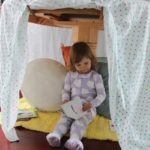
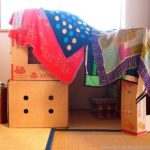
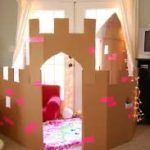
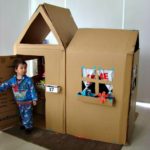




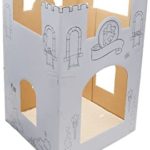
Learning Opportunities
This activity seems simple, but it offers an incredible opportunity for dramatic play, independent play, self-reliance, and many other valuable life skills.
Building the fort uses S.T.E.M. skills, especially engineering and mathematics. Having said that, you must encourage your child to come up with plans to build a fort, engage them in figuring out how to make it safe and solid, how to make sure it does not crumble to the ground and all the other engineering issues to keep in mind. Encourage them to problem-solve and keep building, even start over as many times as they want, until they have a good fort.
Extended Learning Opportunities
Invite your child to try making an outdoor fort:
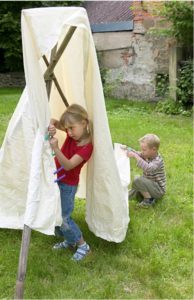
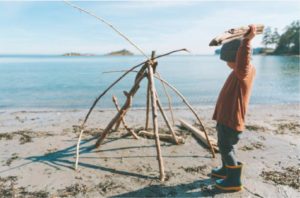
Invite each child (friends – when we can have friends over again- or siblings) to build their own fort for the stay or the weekend, for extended play. It would be like a little neighborhood! It would be a really fun idea for a birthday party. See below some ideas (you can tell these were not built just by children, but just for inspiration):

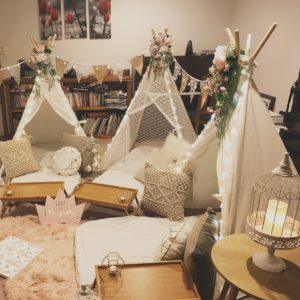
If your child really loves having a fort, you can always think of helping them make it a permanent part of their bedroom or your house by building it in a closet or crawl space! See some ideas:


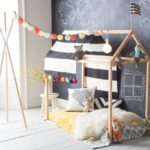
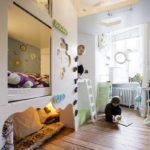
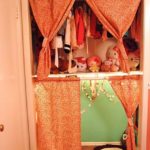

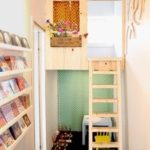
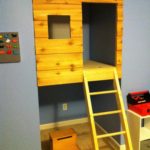
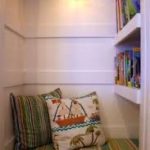
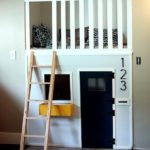
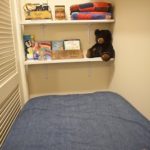

Invite your children to build a fort for their pet!
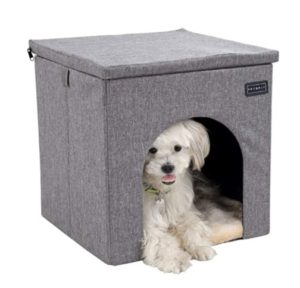
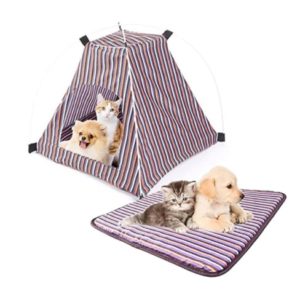
Oh, the magical things we can do!
I wish you days and days of fun!
Books Your Child Might Like
Toys Your Child Might Like
